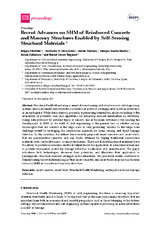Mostrar el registro sencillo del ítem
Recent Advances on SHM of Reinforced Concrete and Masonry Structures Enabled by Self-Sensing Structural Materials
| dc.contributor.author | Ubertini, Filippo | |
| dc.contributor.author | D’Alessandro, Antonella | |
| dc.contributor.author | Downey, Austin | |
| dc.contributor.author | García Macías, Enrique | |
| dc.contributor.author | Laflamme, Simon | |
| dc.contributor.author | Castro Triguero, Rafael | |
| dc.date.accessioned | 2018-11-02T07:41:33Z | |
| dc.date.available | 2018-11-02T07:41:33Z | |
| dc.date.issued | 2018 | |
| dc.identifier.uri | http://hdl.handle.net/10396/17384 | |
| dc.description.abstract | Structural Health Monitoring is aimed at transforming civil structures into self-diagnosing systems able to automatically reveal the occurrence of a fault or a damage after a critical event such as an earthquake. While data science is presently experiencing tremendous advances leading to the availability of powerful tools and algorithms for extracting relevant information by effectively fusing data provided by different types of sensors, one of the main bottlenecks still limiting the development of SHM in the field of civil engineering is the general lack of reliable sensing technologies that are scalable at the large scale. A very promising solution to this large scale challenge would be leveraging the construction materials for strain sensing and direct damage detection. In this direction, the authors have recently proposed smart concretes and smart bricks that are piezoresistive concretes and clay bricks obtained by doping traditional construction materials with conductive nano- or micro-inclusions. These novel multifunctional materials have the ability to provide measurable electrical output under the application of a mechanical load and to provide information useful for damage detection, localization and quantification. The paper introduces both technologies, discusses their potentials, and illustrates their application to paradigmatic structural elements arranged in the laboratory. The presented results contribute to demonstrating the revolutionary impact that smart concretes and smart bricks may have in the near future on SHM of concrete and masonry structures. | es_ES |
| dc.format.mimetype | application/pdf | es_ES |
| dc.language.iso | eng | es_ES |
| dc.publisher | MDPI | es_ES |
| dc.rights | https://creativecommons.org/licenses/by/4.0/ | es_ES |
| dc.source | Proceedings 2(3), 119 (2018) | es_ES |
| dc.subject | Smart concrete | es_ES |
| dc.subject | Smart brick | es_ES |
| dc.subject | Structural Health Monitoring | es_ES |
| dc.subject | Earthquake-induced damage detection | es_ES |
| dc.title | Recent Advances on SHM of Reinforced Concrete and Masonry Structures Enabled by Self-Sensing Structural Materials | es_ES |
| dc.type | info:eu-repo/semantics/article | es_ES |
| dc.relation.publisherversion | http://dx.doi.org/10.3390/ecsa-4-04889 | es_ES |
| dc.rights.accessRights | info:eu-repo/semantics/openAccess | es_ES |

